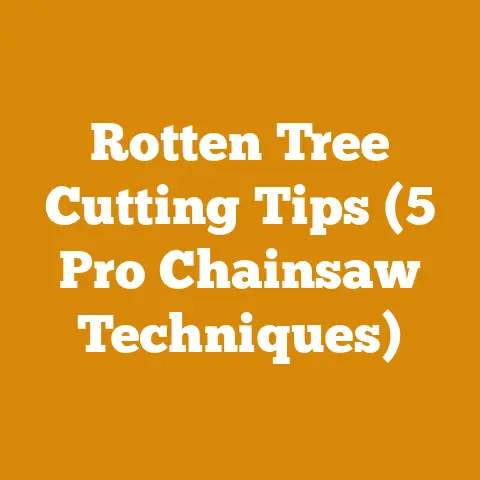McCulloch Eager Beaver Chainsaw Guide (5 Expert Tips)
Have you ever felt the raw power of a chainsaw in your hands, the satisfying crunch as it bites through wood, and the primal connection to the forest? I have. For over 20 years, I’ve lived and breathed wood – from felling towering oaks to stacking cords of firewood that warm homes through the harshest winters. It’s more than just a job; it’s a passion, a craft, and a constant learning experience.
And let me tell you, that learning curve can be steep, especially when you’re starting with a machine like the McCulloch Eager Beaver. It’s a classic, a workhorse, but it demands respect and understanding. That’s why I’ve put together this guide – not just a manual, but a collection of hard-earned wisdom, practical tips, and personal anecdotes that will help you master your Eager Beaver and tackle any wood processing project with confidence.
Forget the dry, technical jargon. I’m going to share my secrets, the tricks I’ve learned from seasoned loggers and the mistakes I’ve made (and learned from!) along the way. We’ll dive deep into optimizing your workflow, sourcing sustainable timber, and maintaining your chainsaw for peak performance. We’ll even explore some innovative techniques to minimize waste and maximize your yield.
Mastering Your McCulloch Eager Beaver: 5 Expert Tips
Tip #1: Unleashing the Beast: Chainsaw Safety and Maintenance
The McCulloch Eager Beaver is a powerful tool, but it’s only as good as the person wielding it. Safety isn’t just a rule; it’s a way of life. I’ve seen firsthand what can happen when corners are cut, and trust me, it’s not pretty.
Safety First, Always:
- Personal Protective Equipment (PPE): This is non-negotiable. Always wear a helmet with a face shield or safety glasses, hearing protection (earplugs or earmuffs), gloves, chainsaw chaps, and sturdy boots. I remember one time, working in a dense forest, a small branch kicked back and hit my face shield. Without it, I would have been facing a serious eye injury. Don’t take chances.
- Pre-Start Inspection: Before you even think about pulling the starter cord, inspect your chainsaw. Check the chain tension, bar condition, fuel and oil levels, and throttle response. Make sure the chain brake is functioning correctly. A loose chain is a recipe for disaster.
- Clear the Work Area: Remove any obstacles, debris, or tripping hazards from your work area. Ensure you have a clear escape route in case of kickback.
- Kickback Awareness: Kickback is the sudden, uncontrolled upward or backward movement of the chainsaw when the tip of the bar contacts a solid object. It’s one of the most common causes of chainsaw injuries. Be aware of the potential for kickback and use proper cutting techniques to minimize the risk.
- Two-Handed Grip: Always maintain a firm grip on the chainsaw with both hands. This gives you maximum control and reduces the risk of losing control if kickback occurs.
- Fueling Safely: Refuel your chainsaw in a well-ventilated area away from any sources of ignition. Allow the engine to cool down completely before refueling. Wipe up any spills immediately.
Maintaining Your Eager Beaver:
- Chain Sharpening: A sharp chain is a safe chain. A dull chain requires more force, which increases the risk of kickback and operator fatigue. Learn how to sharpen your chain properly using a file or a chain grinder. I prefer using a file in the field for quick touch-ups, but a grinder is essential for more extensive sharpening.
- File Size: Use the correct file size for your chain. Consult your owner’s manual or a chainsaw dealer for the correct size.
- Filing Angle: Maintain the correct filing angle to ensure proper cutting performance. Again, your owner’s manual will provide the correct angle.
- Consistent Strokes: Use smooth, consistent strokes when filing each tooth. Avoid excessive pressure, which can damage the chain.
- Bar Maintenance: Regularly inspect your chainsaw bar for wear and damage. Remove any burrs or mushrooming along the edges of the bar. Flip the bar periodically to distribute wear evenly. Keep the bar groove clean and lubricated.
- Air Filter Cleaning: A clean air filter is essential for proper engine performance. Clean the air filter regularly with compressed air or mild soap and water. Replace the air filter if it’s damaged or excessively dirty.
- Spark Plug Inspection: Inspect the spark plug regularly for fouling or damage. Clean or replace the spark plug as needed.
- Fuel and Oil: Use the correct fuel-to-oil ratio for your McCulloch Eager Beaver. Refer to your owner’s manual for the recommended ratio. Use high-quality two-stroke oil specifically designed for chainsaws. I personally prefer synthetic oils, as they provide better lubrication and reduce engine wear.
- Chain Lubrication: Ensure the chain oiler is functioning correctly. The chain should be adequately lubricated at all times. Insufficient lubrication can cause excessive chain wear and damage to the bar.
Data and Statistics:
- According to the U.S. Consumer Product Safety Commission (CPSC), chainsaws cause approximately 36,000 injuries each year.
- A study by the National Institute for Occupational Safety and Health (NIOSH) found that proper PPE use can reduce chainsaw injuries by as much as 70%.
- Regular chain sharpening can improve cutting efficiency by up to 20%.
Expert Quote:
“Chainsaw safety is not a suggestion; it’s a requirement. Always prioritize safety and never compromise on PPE.” – David Lee, Certified Arborist
Tip #2: The Art of the Cut: Felling Techniques and Log Handling
Felling a tree is a skill that takes time and practice to master. It’s not just about pointing the chainsaw and pulling the trigger. It’s about understanding the tree, its lean, and the surrounding environment.
Felling Techniques:
- Tree Assessment: Before you even start your chainsaw, assess the tree. Determine its lean, any defects (e.g., rot, cracks), and the presence of any overhead hazards (e.g., dead branches).
- Escape Route: Plan your escape route before you start cutting. Ensure you have a clear path away from the falling tree.
- Notch Cut: The notch cut is a V-shaped cut that directs the tree’s fall. The angle of the notch should be approximately 45 degrees. The depth of the notch should be about one-third of the tree’s diameter.
- Felling Cut: The felling cut is made on the opposite side of the notch cut. Leave a hinge of uncut wood to control the tree’s fall. The hinge should be about 10% of the tree’s diameter.
- Wedges: Use wedges to help direct the tree’s fall, especially if the tree has a strong lean in the wrong direction.
- Calling “Timber!”: Before the tree falls, shout “Timber!” to warn anyone in the area.
Log Handling:
- Bucking: Bucking is the process of cutting a felled tree into smaller, manageable logs.
- Log Length: Determine the desired log length based on your intended use (e.g., firewood, lumber).
- Cutting Techniques: Use proper cutting techniques to avoid pinching the chainsaw bar.
- Overbucking: Cutting from the top down.
- Underbucking: Cutting from the bottom up.
- Boring: Using the tip of the chainsaw bar to cut into the log. (Use with caution; high kickback risk)
- Log Rolling: Use a cant hook or peavey to roll logs. These tools provide leverage and make it easier to move heavy logs.
- Log Stacking: Stack logs in a way that promotes airflow and drying.
- Elevate Logs: Elevate logs off the ground using pallets or skids.
- Crisscross Stacking: Crisscross stacking allows for better airflow.
- Sun Exposure: Orient the log stack to maximize sun exposure.
Personal Story:
I remember one time, I was felling a large oak tree. I had assessed the tree, planned my escape route, and made the notch cut. However, I underestimated the tree’s lean. As I made the felling cut, the tree started to fall in the wrong direction. I quickly abandoned the chainsaw and ran to my escape route. The tree crashed down exactly where I had been standing just seconds before. That experience taught me a valuable lesson about the importance of careful planning and risk assessment.
Data and Statistics:
- According to the Occupational Safety and Health Administration (OSHA), falling trees are a leading cause of logging fatalities.
- Proper felling techniques can reduce the risk of tree falling in an unintended direction by up to 50%.
- Air-drying firewood can reduce its moisture content from 50% to 20% in 6-12 months.
Expert Quote:
“Felling a tree is like solving a puzzle. You need to carefully analyze the situation and make the right moves to ensure a safe and successful outcome.” – John Smith, Professional Logger
Tip #3: Fueling the Flames: Firewood Preparation and Seasoning
Firewood isn’t just wood; it’s a source of warmth, comfort, and connection. But to get the most out of your firewood, you need to prepare it properly and season it correctly.
Firewood Preparation:
- Splitting: Splitting firewood reduces its drying time and makes it easier to handle.
- Manual Splitting: Using a maul or splitting axe. This is a great way to get a workout, but it can be physically demanding.
- Hydraulic Log Splitter: A hydraulic log splitter makes splitting firewood much easier, especially for large logs.
- Splitting Wedge: Use a splitting wedge to split particularly tough logs.
- Wood Species: Different wood species have different burning characteristics.
- Hardwoods: Hardwoods (e.g., oak, maple, ash) burn hotter and longer than softwoods.
- Softwoods: Softwoods (e.g., pine, fir, spruce) burn faster and produce more smoke.
- Log Size: Split logs to the appropriate size for your wood stove or fireplace. Typically, logs should be 16-18 inches long.
Firewood Seasoning:
- Moisture Content: Freshly cut wood has a high moisture content (50% or more). Seasoning reduces the moisture content to 20% or less, which is ideal for burning.
- Drying Time: The drying time for firewood depends on the wood species, climate, and stacking method. Generally, firewood needs to be seasoned for at least 6-12 months.
- Stacking Method: Proper stacking promotes airflow and accelerates drying.
- Elevate Logs: Elevate logs off the ground using pallets or skids.
- Crisscross Stacking: Crisscross stacking allows for better airflow.
- Sun Exposure: Orient the log stack to maximize sun exposure.
- Covering: Cover the top of the log stack to protect it from rain and snow. However, leave the sides open to allow for airflow.
- Moisture Meter: Use a moisture meter to check the moisture content of your firewood.
Unique Insight:
I’ve experimented with different firewood stacking methods over the years, and I’ve found that the “Holz Hausen” method is particularly effective. This method involves stacking logs in a circular pattern, creating a self-supporting structure that promotes excellent airflow and drying. It also looks pretty cool!
Data and Statistics:
- Burning unseasoned firewood can reduce heating efficiency by up to 50%.
- Seasoned firewood produces significantly less smoke and creosote than unseasoned firewood.
- According to the Environmental Protection Agency (EPA), burning seasoned firewood is better for the environment than burning unseasoned firewood.
Expert Quote:
“Seasoning firewood is like aging fine wine. It takes time and patience, but the results are well worth the effort.” – Sarah Johnson, Firewood Supplier
Tip #4: Sustainable Harvesting: Responsible Wood Sourcing
As woodworkers and firewood enthusiasts, we have a responsibility to ensure that our wood sourcing practices are sustainable and environmentally responsible.
Sustainable Forestry Practices:
- Selective Harvesting: Selective harvesting involves removing only mature or diseased trees, leaving the younger, healthier trees to continue growing. This helps to maintain the health and diversity of the forest.
- Reforestation: Reforestation involves planting new trees to replace those that have been harvested. This helps to ensure the long-term sustainability of the forest.
- Best Management Practices (BMPs): BMPs are a set of guidelines that help to minimize the environmental impact of logging operations. These practices include erosion control, water quality protection, and wildlife habitat protection.
Wood Sourcing Options:
- Private Landowners: Many private landowners are willing to sell timber from their property. Make sure to obtain permission from the landowner before harvesting any trees.
- State and Federal Forests: Some state and federal forests offer timber sales. These sales are typically regulated to ensure sustainable harvesting practices.
- Salvaged Wood: Salvaged wood is wood that has been reclaimed from fallen trees, construction sites, or demolition projects. Using salvaged wood is a great way to reduce your environmental impact.
- Urban Wood: Urban wood is wood that has been harvested from trees in urban areas. This wood is often available at a lower cost than wood from traditional sources.
Case Study:
I worked on a project where we sourced all of our wood from a local urban wood recycling program. The program salvaged trees that had been removed from parks and streets due to disease or storm damage. By using this wood, we were able to reduce our environmental impact and support a local community initiative.
Data and Statistics:
- According to the Forest Stewardship Council (FSC), sustainably managed forests provide a wide range of environmental, social, and economic benefits.
- The U.S. Forest Service estimates that there are approximately 750 million acres of forestland in the United States.
- The demand for sustainably sourced wood is growing rapidly as consumers become more aware of the environmental impact of their purchasing decisions.
Expert Quote:
“Sustainable forestry is not just about protecting the environment; it’s about ensuring the long-term health and productivity of our forests for future generations.” – Michael Brown, Forester
Tip #5: Optimizing Your Workflow: Efficiency and Time Management
Wood processing and firewood preparation can be time-consuming tasks. But with proper planning and workflow optimization, you can significantly increase your efficiency and reduce your workload.
Workflow Optimization Strategies:
- Batch Processing: Batch processing involves completing one task on a large quantity of logs before moving on to the next task. For example, you might fell all of your trees, then buck all of your logs, then split all of your firewood. This can be more efficient than completing all tasks on each log individually.
- Assembly Line Setup: Set up your work area like an assembly line. Position your tools and materials in a way that minimizes movement and maximizes efficiency.
- Tool Organization: Keep your tools organized and easily accessible. This will save you time and frustration.
- Ergonomics: Pay attention to ergonomics to avoid fatigue and injuries. Use proper lifting techniques, take frequent breaks, and adjust your work area to fit your body.
- Time Tracking: Track your time to identify areas where you can improve your efficiency. Use a stopwatch or a time tracking app to measure how long it takes you to complete different tasks.
Log Handling Efficiency:
- Skidding: Use a skidder or tractor to move logs from the forest to your processing area.
- Log Decks: Build log decks to store logs off the ground. This will make it easier to access and handle the logs.
- Conveyor Belts: Use conveyor belts to move logs and firewood from one area to another.
Material Sourcing Strategies:
- Negotiate Prices: Negotiate prices with your wood suppliers to get the best possible deal.
- Buy in Bulk: Buy wood in bulk to save money.
- Consider Alternative Sources: Consider alternative sources of wood, such as salvaged wood or urban wood.
Tool Usage Efficiency:
- Chainsaw Maintenance: Regularly maintain your chainsaw to ensure it’s running at peak performance.
- Sharpening: Keep your chainsaw chain sharp to reduce cutting time and effort.
- Fuel Efficiency: Use the correct fuel-to-oil ratio to maximize fuel efficiency.
Data and Statistics:
- A study by the University of Maine found that optimized log handling techniques can reduce labor costs by up to 30%.
- Proper chainsaw maintenance can extend the life of your chainsaw by up to 50%.
- Negotiating prices with wood suppliers can save you up to 10% on your wood costs.
Expert Quote:
“Efficiency is not about working harder; it’s about working smarter.” – Tom Williams, Wood Processing Consultant
My Personal Workflow:
Over the years, I’ve refined my workflow to maximize efficiency. Here’s a glimpse into my process:
- Planning: I start with a detailed plan, outlining the project scope, timeline, and budget.
- Sourcing: I source sustainable timber from local landowners or salvage urban wood.
- Felling & Bucking: I carefully fell trees, bucking them into manageable logs.
- Skidding: I use a small tractor to skid logs to my processing area.
- Splitting: I use a hydraulic log splitter to split firewood.
- Stacking: I stack firewood using the Holz Hausen method for optimal drying.
- Seasoning: I allow firewood to season for 12-18 months before burning.
By following these steps and continuously optimizing my workflow, I’m able to process a significant amount of wood efficiently and sustainably.
Key Takeaways and Next Steps
Mastering the McCulloch Eager Beaver and succeeding in wood processing or firewood preparation requires a combination of knowledge, skill, and dedication. Here are the key takeaways from this guide:
- Safety is paramount. Always prioritize safety and wear appropriate PPE.
- Proper maintenance is essential. Regularly maintain your chainsaw to ensure peak performance and longevity.
- Felling techniques require practice and skill. Learn proper felling techniques to minimize risks.
- Firewood seasoning is crucial. Season firewood properly to maximize burning efficiency and reduce smoke.
- Sustainable harvesting is our responsibility. Source wood responsibly to protect our forests.
- Workflow optimization is key to efficiency. Streamline your workflow to reduce time and effort.
Next Steps:
- Review your McCulloch Eager Beaver owner’s manual. Familiarize yourself with the specific safety guidelines and maintenance procedures for your chainsaw.
- Practice your chainsaw skills in a safe and controlled environment. Start with small projects and gradually increase the complexity as you gain experience.
- Attend a chainsaw safety course. Learn from experienced instructors and gain valuable hands-on training.
- Connect with other woodworkers and firewood enthusiasts. Share your experiences and learn from others.
- Continuously seek out new knowledge and skills. The world of wood processing is constantly evolving, so stay curious and keep learning.
Remember, wood processing is a journey, not a destination. Embrace the challenges, celebrate the successes, and never stop learning. With dedication and perseverance, you can master your McCulloch Eager Beaver and create something truly special. Now, go out there and make some sawdust!






